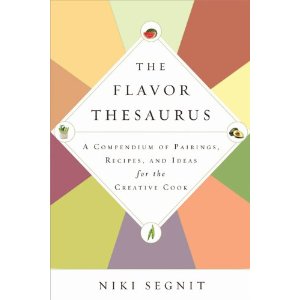Going to the grocery store can be a daunting task. There are a multitude of aisles filled with countless types of food, making it easy to get distracted and overwhelmed. How is anyone supposed to take these odds and ends and concoct a delicious meal? How can someone even know where to begin?
That’s where Niki Segnit’s incredible guide to flavors comes in. The Flavor Thesaurus: A Compendium of Pairings, Recipes and Ideas for the Creative Cook spotlights 99 specific flavors, ranging from anise to liver, and combines them in more than 1,000 pairings. On the inside of the front cover, there is a wheel displaying all 99 flavors and the flavor families they each fall into. For example, one flavor family is “mustardy,” which includes watercress, caper, and horseradish. Segnit uses these flavor families as chapters to divide the book.
The inspiration for this book came to her when she realized how reliant she was on cookbooks. Segnit noticed that many people she knew were able to whip up a delicious meal without referencing a recipe. How, she wondered, do they know what foods work well together, and which do not without learning it from a recipe? So to answer that question, she set out to achieve a true understanding of these 99 flavors and how they compliment one another.
Aside from researching the way flavors combine, Segnit also attempts to define flavor itself. She writes that flavor is not the same as taste, in that taste will indicate whether food is sweet, salty, sour, bitter, or savory. The way Segnit explains the concept of taste versus flavor to the reader is that taste is something that can be detected even when someone holds his or her nose while eating. Flavor is related to smell and has an element of subjectivity to it. So what tastes good to Segnit may not satisfy the pallettes of all readers, but her recommendations are well researched and are definitely worth exploring.
Each chapter is subdivided into the specific flavors that make up each flavor family. The first flavor that is spotlighted in the very first section—“roasted”—is chocolate. She explores the more common chocolate flavor pairings, such as chocolate and hazelnut, but she also encourages fellow foodies to branch out with pairings such as chocolate and tomatoes. With each description of the flavor pair, Segnit provides either a story or history about the combination, and provides an idea about how exactly to combine the flavors together in a dish. Unlike the typical cookbook, however, she never provides a recipe equipped with specific ingredients and instructions. The Flavor Thesaurus is meant to act as more of an inspiration than a set of directions for making lip-smacking cuisine.
Any reader who loves experimenting with food could spend hours leafing through this adventurous take on the average cookbook. What’s great about this book is that it has a little something for everyone, no matter your likes, dislikes, allergies or dietary restrictions. Some of the most interesting entries that I read, and am dying to try, include combinations like onion and orange, egg and vanilla, and avocado with chocolate. There are countless pairings in this book that I would never have considered combining on my own, which makes it all the more interesting. This thesaurus would make the perfect present for any daring food lover.

